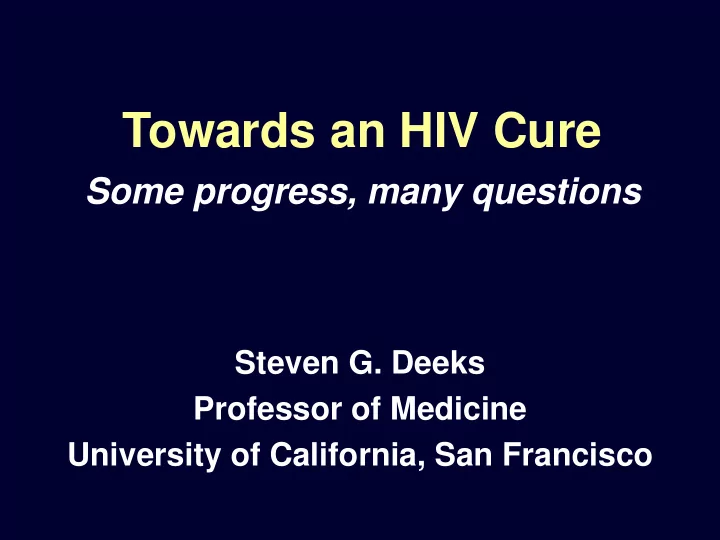

Towards an HIV Cure Some progress, many questions Steven G. Deeks Professor of Medicine University of California, San Francisco
Low-Level Viremia Persists Despite Effective ART 8 36349 36160 36166 36488 Log vRNA Copies/ml 7 36253 36353 6 36348 36544 36661 5 4 3 2 Start Treatment 1 0 0 5 10 15 20 25 30 35 Weeks Post Infection
• Most (90%) HIV DNA is defective • Of the apparently replication-competent virus, only a small subset is induced in vitro • Size of relevant reservoir is not really known
There are three well-characterized non-mutually exclusive mechanisms for stability of the “reservoir” HIV Latency replication (Memory (lack of potency; T cell CD4+ T cells, activation; tissue sanctuaries; failed host other) clearance) T cell proliferation Antigen/TCR, cytokine
Functional Cure • Long-term health in absence of therapy (“functional cure”) – Cancer model (remission) – Occurs in ~1% of natural infections • Will there be residual disease? • Approach: Enhance HIV-specific immunity
Sterilizing Cure • Complete eradication of all replication competent virus (“sterilizing cure”) – Is this remotely possible? – Is this necessary? – How can this be proven? • Approach: “Shock and Kill”, gene therapy
How will HIV be eliminated or controlled in absence of ART? • Prevent latency (early ART) • Reverse latency (“shock”) • Clear virus- producing cells (“kill”) • Modify host enviroment • Gene therapy/HST
Can we cure HIV with very early therapy?
• ART started at 31 hours Closed symbols= Detectable and interrupted at ~18 19,812 c/ml (4.3 log) Open Symbols= Undetectable Viral Load months • Classic viral decay 2,617 c/ml (3.4 log) consistent with infection 516 c/ml (2.7 log) 265 c/ml (2.4 log) of infant’s T cell population <48 c/ml (<1.68 log) • HIV seronegative; no consistently detectable HIV; no protective HLA alleles AZT/3TC/NVP A ZT /3 TC /L PV/r 31 hours – 7 days 7 days – 18 m onths
Mississippi Child: HIV rebounded at month 27
• ART at day 3 prevents seeding in blood, but not lymph node/gut • Virus rebound delayed but not prevented by early ART • Caveats: large bolus, short- term non-optimized ART • A delay in starting ART for a few days results in > 1 log 10 increase in reservoir size (Okoye/Picker)
Is early ART doomed to fail? Hatano: ART during “hyperacute” (end of eclipse period) in PrEP failures prevents detectable seeding of HIV in blood and tissues
• 14 subjects who started therapy early (but not Fiebig I/II), remained on therapy for years, and had no rebound after stopping therapy • Lack CTL and protective HLA alleles • Low reservoir of replication-competent virus • HIV DNA declines in absence of ART (n=4) • Very low T cell activation
Shock and Kill
Shock and Kill
Vorinostat (SAHA) increases RNA production during ART but does not cause virus production (Margolis/Lewin)
Romidepsin stimulates virus production Søgaard and colleagues; AIDS 2014 (abstract TUAA0106LB)
Despite clear efficacy as a “shock”, romidepsin does not affect the reservoir size Søgaard and colleagues; AIDS 2014 (abstract TUAA0106LB)
Can we enhanced killing of HIV-infected cells in vivo ?
• CMV as SIV vaccine vector causes high levels of tissue-based effector CD8+ T cells that target novel epitopes • These cells prevent/clear latency during early infection, 50 100 150 resulting in cure (as Time (weeks) shown by challenge studies)
HIV antibodies and cure Broadly neutralizing antibodies inhibit HIV replication in macaques, and can be optimized (if needed) to enhance clearance of virus-producing cells (ADCC)
Can we cure HIV infection with immune-based therapeutics? Immune activation T cell proliferation Negative regulators Enhanced clearance
Cell proliferation maintains the reservoir during ART • Up to 50% of infected cell population (blood) is clonal in nature • Integration sites enriched for genes associated with cell growth/cancer • Latency reversal/T cell activation may stimulate cell proliferation, thus maintaining if not increasing reservoir size
Frequency of HIV DNA- containing resting memory cells correlates with frequency of HLA-DR+ CD4+ T cells (rho=0.65, P=0.006)
Immunotherapy: Reduce T cell activation/proliferation (sirolimus, JAK/STAT inhibitors, anti-INF α ) Immunotherapy: Improve T cell function (anti-PD-1, anti-INF α ) Immunotherapy: Kill virus producing cells (vaccines, BNabs)
Will we need to eradicate all HIV?
Despite dramatic (1000 to 10,000 fold) reductions in “reservoir”, virus rebounded after several months Late rebounds will be hard to diagnose and could have profound effects on patient and his/her partners Modeling: latent reservoir will have to be depleted > 10 5 log10 fold or a durable cure to be likely (Hill, PNAS 14)
Summary • There will be no scalable and safe cure in the foreseeable future • Treatment of hyperacute HIV may still be curative; early ART reduces reservoir and protects immune function (VISCONTI) • Shock (HDAC inhibitors) work, but are not sufficiently potent • A number of adjunctive anti-proliferation/anti- inflammation drugs are moving through pipeline • In absence of host control, profound depletions in reservoir needed, and life long surveillance for late failures needed • A biomarker for reservoir may be highest priority
Acknowledgements SCOPE Cohort / UCSF Elsewhere NIAID Hiroyu Hatano Nicolas Chomont Peter Hunt Rafick Sekaly U19 AI096109, Satish Pillai Remi Fromentin RO1 AI087145, K24AI069994, Charlene Wang Mario Stevenson CNICS Ma Somsouk Sarah Palmer (5R24AI067039), Jeff Martin Daria Hazuda CLIC Rebecca Hoh Sharon Lewin Rick Hecht Bob Siliciano Michael Busch Janet Siliciano Peter Stock Danny Douek Elizabeth Sinclair Michael Lederman Steve Yukl Barbara Shacklett Joe Wong Tim Schacker Mike McCune
Recommend
More recommend